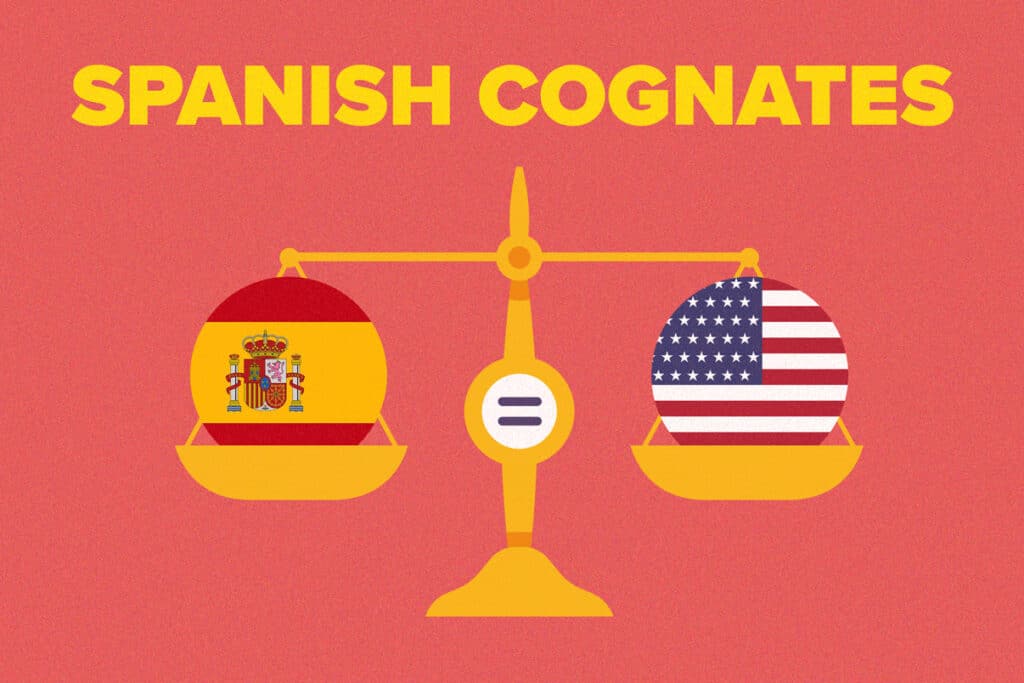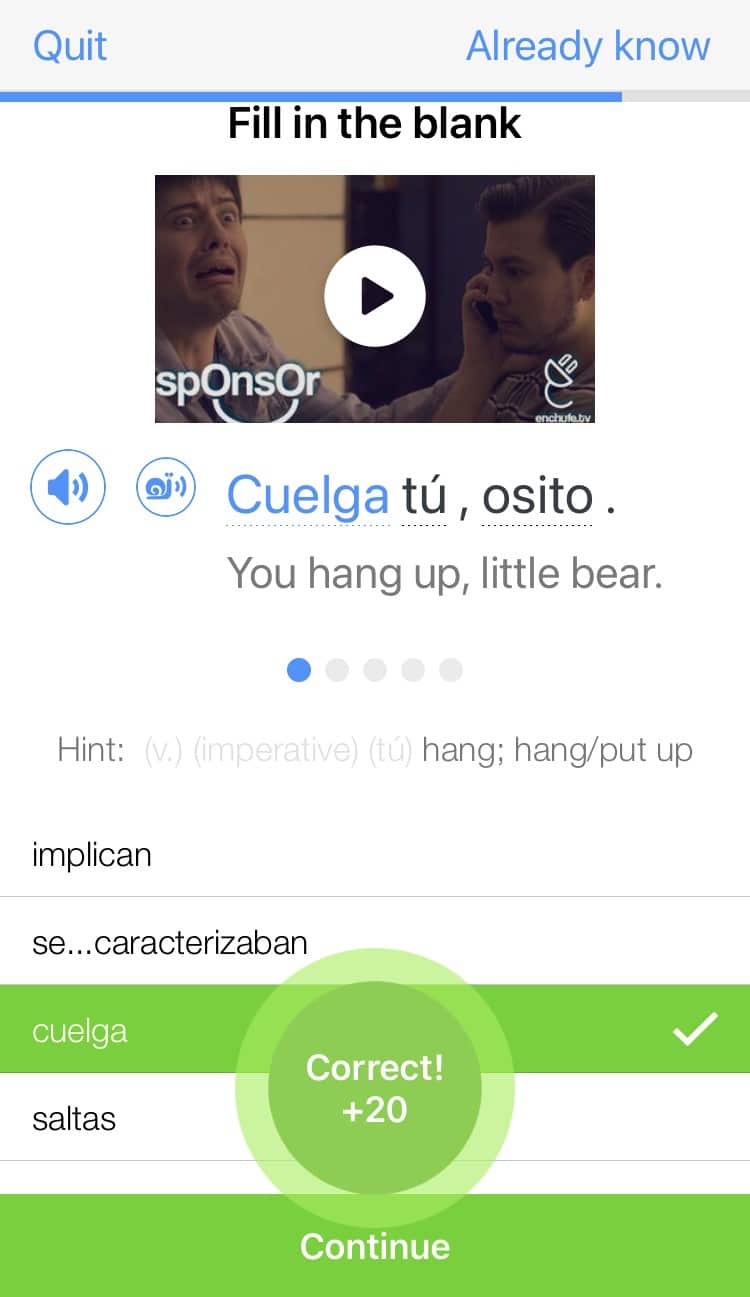
500+ Useful Spanish Cognates (With PDF Download)
Even if today is your first day learning Spanish, you already know plenty of Spanish words.
Actor, animal, bar, color, control… You know them in English, but they’re in italics here because they’re all Spanish cognates!
Spanish and English have many such “twins,” and taking advantage of them will speed up your Spanish learning considerably.
Let’s look at some more words that look exactly (or almost) the same in English and Spanish.
Contents
- What Are Spanish Cognates?
- Common Spanish Cognates
- Rules and Patterns for Spanish Cognates
-
- -ant → -ante / -ente
- -al → -al
- -ar → -ar
- -ary → -ario
- -ate → -ar
- -ble → -ble
- -ct → -cto / -to
- -ic → -ico
- -id → -ido
- -ify (verbs) → -ificar
- -ile → -il
- -ism → -ismo
- -ist → -ista
- -ity → -idad
- -ive → -ivo
- -ly → -mente
- -ment → -mento
- -nce → -ncia
- -nt → -nte
- -or → -or
- -ous → -oso
- -sion → -sión
- -tion → -ción
- And One More Thing…
Download: This blog post is available as a convenient and portable PDF that you can take anywhere. Click here to get a copy. (Download)
What Are Spanish Cognates?
Cognates are words that look identical or similar in two languages and have the same meaning.
English and Spanish have borrowed many words from each other. This is helpful for English-speaking learners of Spanish (and vice versa)!
Cognates are the easiest way to expand your vocabulary. Just a quick look at the word, and you know its meaning.
But even though they look similar, there are often some differences in stress and pronunciation.
Beware of false cognates, though!
Often called “false friends,” these are words that look like cognates but aren’t. We have a full post explaining these here that you can check out after reading this one.
Common Spanish Cognates
Cognates are words that are spelled very similarly or exactly the same in both English and Spanish. And because they’re cognates, they mean exactly the same thing too.
Remember to listen for changes in pronunciation!
| English | Spanish |
|---|---|
| To abandon | Abandonar |
| Accident | Accidente |
| Additional | Adicional |
| To administer | Administrar |
| To admit | Admitir |
| To adopt | Adoptar |
| Adorable | Adorable |
| To affect | Afectar |
| To adjust | Ajustar |
| Alcohol | Alcohol |
| Animal | Animal |
| Art | Arte |
| To assign | Asignar |
| Bank | Banco |
| Bar | Bar |
| Cable | Cable |
| To calculate | Calcular |
| To calm | Calmar |
| Camera | Cámara |
| To cancel | Cancelar |
| Casual | Casual |
| Ceremony | Ceremonia |
| Circle | Círculo |
| To clarify | Clarificar |
| Colony | Colonia |
| Color | Color |
| To comment | Comentar |
| To complement | Complementar |
| To consider | Considerar |
| To consult | Consultar |
| Control | Control |
| To control | Controlar |
| Conventional | Convencional |
| To cooperate | Cooperar |
| To coordinate | Coordinar |
| To create | Crear |
| To dedicate | Dedicar |
| Diary | Diario |
| To eliminate | Eliminar |
| Enemy | Enemigo |
| Essential | Esencial |
| To estimate | Estimar |
| To evaluate | Evaluar |
| Event | Evento |
| To exaggerate | Exagerar |
| Excuse | Excusa |
| To exist | Existir |
| To experiment | Experimentar |
| To facilitate | Facilitar |
| Family | Familia |
| To fascinate | Fascinar |
| To form | Formar |
| Fruit | Fruta |
| To gratify | Gratificar |
| Group | Grupo |
| Hereditary | Hereditario |
| Hospital | Hospital |
| Ideal | Ideal |
| Impartial | Imparcial |
| Insect | Insecto |
| To insert | Insertar |
| To insist | Insistir |
| Instant | Instante |
| To insult | Insultar |
| To integrate | Integrar |
| To limit | Limitar |
| Limit | Límite |
| Memorable | Memorable |
| To modify | Modificar |
| To motivate | Motivar |
| Muscular | Muscular |
| Music | Música |
| To necessitate; to need | Necesitar |
| Note | Nota |
| Ocean | Océano |
| To pacify | Pacificar |
| Part | Parte |
| Particular | Particular |
| Plant | Planta |
| Poem | Poema |
| To present | Presentar |
| President | Presidente |
| Problem | Problema |
| Radio | Radio |
| To rectify | Rectificar |
| Religion | Religión |
| To represent | Representar |
| Secret | Secreto |
| Silence | Silencio |
| Temperature | Temperatura |
| Temporal | Temporal |
| Tolerable | Tolerable |
| Tropical | Tropical |
| Vital | Vital |
Rules and Patterns for Spanish Cognates
Knowing the patterns cognates follow makes it much easier to take an educated guess when you’re not sure of a word!
For example, if you aren’t 100% sure how to say “professional” in Spanish during a conversation, you might say profesional because you know the Spanish cognate patterns—and in this case, you’d be correct.
Here are the most common patterns for Spanish cognates that you should commit to memory:
-ant → -ante / -ente
| English | Spanish |
|---|---|
| assistant | asistente |
| brilliant | brillante |
| constant | constante |
| distant | distante |
| dominant | dominante |
| elegant | elegante |
| extravagant | extravagante |
| exuberant | exuberante |
| fragrant | fragante |
| giant | gigante |
| ignorant | ignorante |
| immigrant | inmigrante |
| important | importante |
| militant | militante |
| occupant | ocupante |
| participant | participante |
| rampant | rampante |
| relevant | relevante |
| tolerant | tolerante |
-al → -al
| English | Spanish |
|---|---|
| accidental | accidental |
| capital | capital |
| central | central |
| commercial | comercial |
| criminal | criminal |
| cultural | cultural |
| digital | digital |
| educational | educacional |
| emotional | emocional |
| exceptional | excepcional |
| final | final |
| formal | formal |
| functional | funcional |
| global | global |
| gradual | gradual |
| industrial | industrial |
| integral | integral |
| international | internacional |
| legal | legal |
| local | local |
| manual | manual |
| material | material |
| metal | metal |
| musical | musical |
| national | nacional |
| natural | natural |
| original | original |
| parental | parental |
| personal | personal |
| professional | profesional |
| rural | rural |
| social | social |
| special | especial |
| total | total |
-ar → -ar
| English | Spanish |
|---|---|
| angular | angular |
| cellular | celular |
| circular | circular |
| familiar | familiar |
| lunar | lunar |
| molecular | molecular |
| polar | polar |
| popular | popular |
| regular | regular |
| secular | secular |
| similar | similar |
| singular | singular |
| spectacular | espectacular |
| stellar | estelar |
| vascular | vascular |
| vulgar | vulgar |
-ary → -ario
| English | Spanish |
|---|---|
| complementary | complementario |
| stacionary | estacionario |
| extraordinary | extraordinario |
| honorary | honorario |
| imaginary | imaginario |
| involuntary | involuntario |
| literary | literario |
| necessary | necesario |
| ordinary | ordinario |
| solitary | solitario |
| vocabulary | vocabulario |
-ate → -ar
| English | Spanish |
|---|---|
| activate | activar |
| appreciate | apreciar |
| celebrate | celebrar |
| collaborate | colaborar |
| communicate | comunicar |
| decorate | decorar |
| demonstrate | demostrar |
| educate | educar |
| investigate | investigar |
| operate | operar |
| participate | participar |
| regulate | regular |
-ble → -ble
| English | Spanish |
|---|---|
| admirable | admirable |
| amiable | amable |
| audible | audible |
| edible | comestible |
| compatible | compatible |
| feasible | factible |
| flexible | flexible |
| horrible | horrible |
| incredible | increíble |
| indelible | indeleble |
| invincible | invencible |
| noble | noble |
| plausible | plausible |
| possible | posible |
| probable | probable |
| responsible | responsable |
| susceptible | susceptible |
| tangible | tangible |
| terrible | terrible |
| visible | visible |
| vulnerable | vulnerable |
-ct → -cto / -to
| English | Spanish |
|---|---|
| abstract | abstracto |
| architect | arquitecto |
| aspect | aspecto |
| compact | compacto |
| conflict | conflicto |
| contact | contacto |
| correct | correcto |
| defect | defecto |
| direct | directo |
| distinct | distinto |
| effect | efecto |
| strict | estricto |
| exact | exacto |
| indirect | indirecto |
| instinct | instinto |
| intact | intacto |
| object | objeto |
| perfect | perfecto |
| prospect | prospecto |
| project | proyecto |
| respect | respeto |
| subject | sujeto |
-ic → -ico
| English | Spanish |
|---|---|
| artistic | artístico |
| basic | básico |
| classic | clásico |
| economic | económico |
| electric | eléctrico |
| electronic | electrónico |
| fantastic | fantástico |
| genetic | genético |
| historic | histórico |
| ironic | irónico |
| linguistic | lingüístico |
| organic | orgánico |
| panic | pánico |
| plastic | plástico |
| psychic | psíquico |
| public | público |
| romantic | romántico |
| scientific | científico |
| specific | específico |
| strategic | estratégico |
| tragic | trágico |
-id → -ido
| English | Spanish |
|---|---|
| acid | ácido |
| stupid | estúpido |
| intrepid | intrépido |
| liquid | líquido |
| rapid | rápido |
| solid | sólido |
| timid | tímido |
| valid | válido |
-ify (verbs) → -ificar
| English | Spanish |
|---|---|
| amplify | amplificar |
| classify | clasificar |
| codify | codificar |
| dignify | dignificar |
| identify | identificar |
| justify | justificar |
| notify | notificar |
| petrify | petrificar |
| simplify | simplificar |
| specify | especificar |
-ile → -il
| English | Spanish |
|---|---|
| docile | dócil |
| fragile | frágil |
| hostile | hostil |
| mobile | móvil |
| puerile | pueril |
| sterile | estéril |
-ism → -ismo
| English | Spanish |
|---|---|
| alpinism | alpinismo |
| capitalism | capitalismo |
| communism | comunismo |
| egoism | egoísmo |
| feminism | feminismo |
| mechanism | mecanismo |
| optimism | optimismo |
| organism | organismo |
| racism | racismo |
| realism | realismo |
-ist → -ista
| English | Spanish |
|---|---|
| artist | artista |
| dentist | dentista |
| egoist | egoísta |
| feminist | feminista |
| optimist | optimista |
| pianist | pianista |
| protagonist | protagonista |
| realist | realista |
| tourist | turista |
-ity → -idad
| English | Spanish |
|---|---|
| ability | habilidad |
| activity | actividad |
| adversity | adversidad |
| anxiety | ansiedad |
| authority | autoridad |
| community | comunidad |
| creativity | creatividad |
| curiosity | curiosidad |
| difficulty | dificultad |
| diversity | diversidad |
| equality | igualdad |
| generosity | generosidad |
| hospitality | hospitalidad |
| identity | identidad |
| possibility | posibilidad |
| quality | calidad |
| reality | realidad |
| security | seguridad |
| simplicity | simplicidad |
| university | universidad |
-ive → -ivo
| English | Spanish |
|---|---|
| affirmative | afirmativo |
| attractive | atractivo |
| competitive | competitivo |
| constructive | constructivo |
| creative | creativo |
| decisive | decisivo |
| defensive | defensivo |
| effective | efectivo |
| instinctive | instintivo |
| massive | masivo |
| negative | negativo |
| objective | objetivo |
| passive | pasivo |
| positive | positivo |
| progressive | progresivo |
| reflective | reflexivo |
-ly → -mente
| English | Spanish |
|---|---|
| absolutely | absolutamente |
| basically | básicamente |
| clearly | claramente |
| completely | completamente |
| constantly | constantemente |
| especially | especialmente |
| eventually | eventualmente |
| evidently | evidentemente |
| exactly | exactamente |
| generally | generalmente |
| immediately | inmediatamente |
| naturally | naturalmente |
| obviously | obviamente |
| originally | originalmente |
| personally | personalmente |
| possibly | posiblemente |
| practically | prácticamente |
| principally | principalmente |
| rapidly | rápidamente |
| really | realmente |
| relatively | relativamente |
| seriously | seriamente |
| simply | simplemente |
| sincerely | sinceramente |
| socially | socialmente |
| solely | solamente |
| typically | típicamente |
| totally | totalmente |
-ment → -mento
| English | Spanish |
|---|---|
| argument | argumento |
| complement | complemento |
| department | departamento |
| document | documento |
| experiment | experimento |
| fundament | fundamento |
| instrument | instrumento |
| moment | momento |
| monument | monumento |
| movement | movimiento |
| parliament | parlamento |
| sentiment | sentimiento |
| treatment | tratamiento |
-nce → -ncia
| English | Spanish |
|---|---|
| abundance | abundancia |
| adolescence | adolescencia |
| appearance | apariencia |
| conscience | conciencia |
| difference | diferencia |
| evidence | evidencia |
| excellence | excelencia |
| experience | experiencia |
| influence | influencia |
| independence | independencia |
| obedience | obediencia |
| patience | paciencia |
| reference | referencia |
| resistance | resistencia |
| subsistence | subsistencia |
| transparency | transparencia |
| urgency | urgencia |
-nt → -nte
| English | Spanish |
|---|---|
| abundant | abundante |
| brilliant | brillante |
| constant | constante |
| elegant | elegante |
| excellent | excelente |
| important | importante |
| intelligent | inteligente |
| interesting | interesante |
| patient | paciente |
| sufficient | suficiente |
| valiant | valiente |
| vibrant | vibrante |
-or → -or
| English | Spanish |
|---|---|
| actor | actor |
| author | autor |
| competitor | competidor |
| director | director |
| distributor | distribuidor |
| doctor | doctor |
| editor | editor |
| favor | favor |
| inventor | inventor |
| investor | inversor |
| moderator | moderador |
| motor | motor |
| precursor | precursor |
| professor | profesor |
| rumor | rumor |
| spectator | espectador |
| traitor | traidor |
-ous → -oso
| English | Spanish |
|---|---|
| curious | curioso |
| delicious | delicioso |
| dubious | dudoso |
| famous | famoso |
| generous | generoso |
| glamorous | glamoroso |
| glorious | glorioso |
| luminous | luminoso |
| mysterious | misterioso |
| precious | precioso |
| spacious | espacioso |
| timorous | temeroso |
| valorous | valeroso |
| virtuous | virtuoso |
-sion → -sión
| English | Spanish |
|---|---|
| abrasion | abrasión |
| adhesion | adhesión |
| aggression | agresión |
| ascension | ascensión |
| aversion | aversión |
| cohesion | cohesión |
| comprehension | comprensión |
| concession | concesión |
| conclusion | conclusión |
| confusion | confusión |
| conversion | conversión |
| correlation | correlación |
| decision | decisión |
| dimension | dimensión |
| demission | dimisión |
| discussion | discusión |
| distortion | distorsión |
| division | división |
| emission | emisión |
| expansion | expansión |
| expression | expresión |
| extension | extensión |
| illusion | ilusión |
| impression | impresión |
| inclusion | inclusión |
| immersion | inmersión |
| inversion | inversión |
| mission | misión |
| passion | pasión |
| persuasion | persuasión |
| precision | precisión |
| profession | profesión |
| suspension | suspensión |
| tension | tensión |
| transmission | transmisión |
| version | versión |
| vision | visión |
-tion → -ción
| English | Spanish |
|---|---|
| action | acción |
| addiction | adicción |
| celebration | celebración |
| collaboration | colaboración |
| collection | colección |
| combination | combinación |
| communication | comunicación |
| condition | condición |
| construction | construcción |
| contribution | contribución |
| conversation | conversación |
| correction | corrección |
| definition | definición |
| direction | dirección |
| education | educación |
| election | elección |
| elevation | elevación |
| exception | excepción |
| expectation | expectación |
| explanation | explicación |
| generation | generación |
| imagination | imaginación |
| infection | infección |
| information | información |
| interpretation | interpretación |
| invitation | invitación |
| nation | nación |
| observation | observación |
| occasion | ocasión |
| operation | operación |
| organization | organización |
| population | población |
| position | posición |
| preparation | preparación |
| presentation | presentación |
| prevention | prevención |
| promotion | promoción |
| protection | protección |
| recommendation | recomendación |
| relaxation | relajación |
| respiration | respiración |
| selection | selección |
| situation | situación |
| solution | solución |
| variation | variación |
| vibration | vibración |
Learning cognates can be a cool way of improving your Spanish vocabulary with little effort.
And now you’re more than 500 words closer to becoming a proficient speaker of Spanish!
You can also see these words in use and discover even more Spanish cognates with programs like FluentU. The interactive subtitles let you double-check the meaning of each word in every video you watch, so you don’t have to worry about “false friends.”
FluentU takes authentic videos—like music videos, movie trailers, news and inspiring talks—and turns them into personalized language learning lessons.
You can try FluentU for free for 2 weeks. Check out the website or download the iOS app or Android app.
P.S. Click here to take advantage of our current sale! (Expires at the end of this month)

As always, happy studying!
Download: This blog post is available as a convenient and portable PDF that you can take anywhere. Click here to get a copy. (Download)
And One More Thing…
If you've made it this far that means you probably enjoy learning Spanish with engaging material and will then love FluentU.
Other sites use scripted content. FluentU uses a natural approach that helps you ease into the Spanish language and culture over time. You’ll learn Spanish as it’s actually spoken by real people.
FluentU has a wide variety of videos, as you can see here:

FluentU brings native videos within reach with interactive transcripts. You can tap on any word to look it up instantly. Every definition has examples that have been written to help you understand how the word is used. If you see an interesting word you don’t know, you can add it to a vocab list.

Review a complete interactive transcript under the Dialogue tab, and find words and phrases listed under Vocab.

Learn all the vocabulary in any video with FluentU’s robust learning engine. Swipe left or right to see more examples of the word you’re on.

The best part is that FluentU keeps track of the vocabulary that you’re learning, and gives you extra practice with difficult words. It'll even remind you when it’s time to review what you’ve learned. Every learner has a truly personalized experience, even if they’re learning with the same video.
Start using the FluentU website on your computer or tablet or, better yet, download the FluentU app from the iTunes or Google Play store. Click here to take advantage of our current sale! (Expires at the end of this month.)




